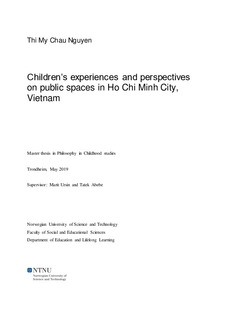| dc.description.abstract | This study aims to explore children’s perspectives and experiences on public spaces in Ho Chi Minh City, Vietnam. It further questions structural and contextual forces that shape children’s everyday experiences in public spaces. Employing methodology perspectives from Childhood studies, it acknowledges children’s social world to be studied in its own right, and the children’s voices are central in the study about them. In that manner, 11 boys and girls aged 6 to 13 living in the city’s core were invited to share their perspectives and experiences through a range of participatory tools, including semi-structured interview, photographing or describing daily activities. Six adult guardians also joined as informants on the topic. Theoretical framework for making sense of data was drawn from key perspectives of Childhood studies: social constructed, structural and actor-oriented. Actor-oriented perspective sees children as active social actors in shaping their own life and their surrounding world. Social constructionism recognizes the role of socio-cultural contexts in shaping different practices and realities of childhood. Meanwhile, application of structural perspectives on childhood study invokes that childhood is a permanent social structure which is impacted by close or distant structural variables; these cannot be missed out in explaining children’s life circumstances at particular time and space. The study found out that children’s perspectives on urban public space were diverse and, in many cases, fluid depending on the conditions in which they found themselves. O n their spatial practice, children used public space for multi-purposes: playing, entertaining, working, navigating and other activities for wellbeing, of which, they most aspired to commuting to public spaces for play and peer companionships. Their experiences in public spaces were complex, ranging from unsatisfying to fulfilling. Yet public spaces were reflectively space for them to express, both within and without social pressures on their identities. With structural view, generational relations, cultural values, and societal changes throughout Vietnam’s recent adoption of development model were identified as important factors that greatly shaped Vietnamese contemporary childhood, including children’s everyday life experience in urban public space. The study suggests its findings to be utilized for evident-based policy making better experiences for children in urban public space. In the meantime, it enthusiastically recommends more studies on the theme children and spaces in Vietnam, as this has been left largely undiscovered, especially by means of child-centered approaches and Childhood studies perspectives. | nb_NO |
